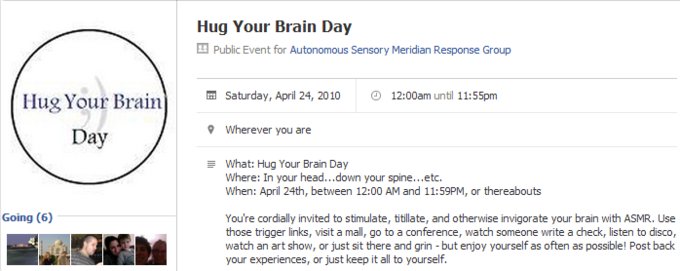About
Autonomous Sensory Meridian Response (ASMR) is a term used to describe a sensory experience characterized by a tingling sensation in the head and scalp, which can be triggered by sounds like whispering or brushing, and visual stimulus like painting or drawing. On YouTube, the phenomenon inspired the creation of “whisperer” videos, in which people attempt to trigger the viewer’s ASMR by speaking in a soft voice and making various sounds with inanimate objects.
Origin
One of the first forum discussions about the phenomenon was started on the Steady Health Forums[3] by member okaywhatever on October 19th, 2007. Titled “Weird Sensation Feels Good”, the thread described a strange itchy sensation triggered by several different social interactions. On June 4th, 2008, SteadyHealth member tingler replied to the thread, who referred to the phenomenon as “Attention Induced Head Orgasm” (AIHO) and claimed to have experienced it for as long as he could remember. In February of 2010, Jennifer Allen coined the term “Autonomous Sensory Meridian Response” when she started a Facebook[5] group dedicated to the sensation.
Spread
According to ASMR blog The Unnamed Feeling[1], the web forum AIHO.org was launched in 2008 for people to discuss the strange sensations. On December 12th, 2008, the “Society of Sensationalists” Yahoo[4] group was launched, which described itself as a place for people seeking answers about the sensations they were feeling. In less than three years, the group accumulated over 3,200 members. On April 24th, the first ASMR-related event was held called “Hug Your Brain Day”[7], which encouraged people engage in activities that triggered ASMR.
On June 16th, 2010, the ASMR Research & Support[8] website was launched by Allen with an aim to support scientific study of the phenomenon. On June 23rd, YouTube channel The Unnamed Feeling[10] was launched, which created playlists highlighting various ASMR triggering videos. On February 17th, 2011, Redditor mahi-mahi submitted a post to the /r/todayilearned[9] subreddit titled "TIL about ASMR, aka “that unnamed feeling” or “head orgasms”, which linked to the ASMR Research & Support homepage. The following day, the /r/ASMR[11] subreddit was created by Redditor MrStonedOne, which served as community for ASMR-triggering web videos. On February 27th, 2012, The Huffington Post[20] published an article titled “ASMR: Orgasms for Your Brain”, reporting on the wide variety of online communities surrounding ASMR. On March 12th, the neuroscience blog Neurologica[27] published a post on ASMR, which noted that the Internet was instrumental in the discovery of the phenomenon.
YouTube Whisperers
On March 26th, 2009, YouTuber WhisperingLife uploaded a video titled “Whisper 1 – hello!”, which featured a woman whispering that she created the channel because she loved to hear people whisper (shown below). On October 8th, 2010, the web forum YouWhisper[13] was launched, where members shared their favorite YouTube whispering videos.
On December 8th, ASMR Research & Support Forums[14] member HFM submitted a thread titled “YouTube and the Whisper Community”, listing YouTuber Soothingwhisper[15] as a notable whisperer. On December 23rd, The Unnamed Feeling[12] published a post titled “ASMR Community on YouTube is Growing”, which noted that many YouTubers were using whispering as a common trigger in ASMR videos.
Wikipedia Entry
On July 18th, 2011, The Unnamed Feeling[16] published a blog post titled “ASMR is now on Wikipedia”, which announced the creation of a Wikipedia[19] page for the phenomenon. In Sepetember of 2011, the page was marked for deletion due to several community members claiming it lacked scientific evidence and reliable sources. On September 19th, The Unnamed Feeling[18] published a post titled “Help Save the ASMR Wikipedia Page!”, calling for readers to assist in improving the entry to save it from deletion. On September 26th, The Unnamed Feeling[17] posted an update that the Wikipedia page had been removed for a lack of scientific evidence.
Notable Examples
External References
[1] Blogspot – ASMR The Story So Far
[2] Blogspot – ASMR Wikipedia Page Shut Down
[3] SteadyHealth – Weird Sensation Feels Good
[4] Yahoo – Society of Sensationalists
[5] Facebook – Autonomous Sensory Meridian Response
[6]ASMR-Research – External Links to ASMR Experiences
[7] Facebook – Huge Your Brain Day
[8]ASMR-Research.org – ASMR Research and Support
[9] Reddit – "TIL about ASMR, aka “that unnamed feeling” or head orgasms
[10] YouTube – The Unnamed Feeling
[12] Blogspot – ASMR Community on YouTube is Growing
[14]ASMR Research & Support – Youtube and the whisper community
[15] YouTube – SoothingWhisper
[16] The Unnamed Feeling – ASMR is Now on Wikipedia
[17] The Unnamed Feeling – ASMR Wikipedia Page Shut Down
[18] The Unnamed Feeling – Help Save the ASMR Wikipedia Page
[19] Wikipedia – Autonomous Sensory Meridian Response
[20] The Huffington Post – ASMR – Orgasms For Your Brain
[21] Android Pit – ASMR – Extreme Relaxation
[22] MetaFilter – There’s a name for that
[23] Anti-Valentine – ASMR – What is This Tingling Sensation in my Head?
[24]ASMR Videos – ASMR Videos
[26] Thought Catalog – I Have ASMR, Do You?

